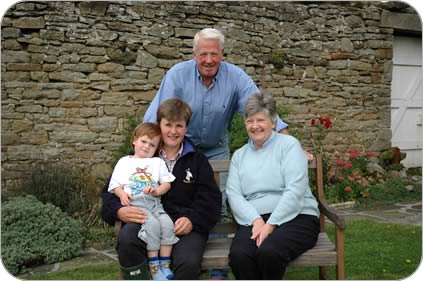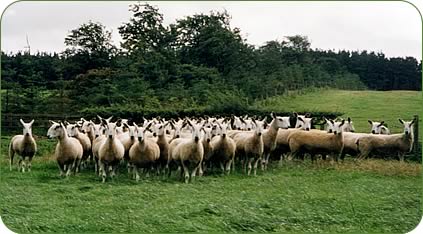Jennifer MacKenzie is an agricultural photo journalist with almost 30 year's experience. Operating from her base in Cumbria, Jennifer undertakes mainly industry-related freelance writing and photography.
Bluefaced Leicesters at the core
 |
The Bluefaced Leicester is renowned for its prolificacy and mothering ability and as a crossing sire it is fundamental in producing the Mule, the core of the UK breeding flock.
And it was these factors, as well as the interest in breeding and showing Bluefaced Leicesters and the friendships which have developed over decades that encouraged Hexhamshire farming family the Bissets to stay loyal to the breed.
Undaunted after foot and mouth, Alex and Doreen Bisset and their daughter Claire were determined to re-build the Middle Dukesfield flock which has been bred on the 240-acre all grass farm since 1975.
Stock at Middle Dukesfield, Steel near Hexham was the last in the area to go on September 25 2001 – all that were saved from the pedigree flock were 20 gimmers on 30 acres of tenanted land at Bywell.
“Claire wanted to carry on so we decided to re-stock the farm,” said Alex. “We have been able to re-build the Bluefaced Leicester flock from those 20 gimmers which were saved along with 130 Mules and Texels. We also bought five ewes at a dispersal sale at Castle Douglas for the Wintonhill flock from Haddington which were by a ram we had bred.
“We had always enjoyed breeding and showing Bluefaced Leicesters so we didn’t see the point of doing anything else.
“There’s always great camaraderie when we go to a show. We all help each other out – but when it comes to going into the ring you are on your own. If you win or lose, after the show we are hopefully all still mates. We have met a lot of very nice people through the breed and we have made some good friends.”
One of these ewes won the breed championship at the 2003 Great Yorkshire Show as a one crop ewe.
The gimmers were by a Scrainwood tup which bred very well for the flock. He was bought as s shearling and bred three crops of lambs before being sold as a three shear.
 |
Now there are 60 Bluefaced Leicester ewes at Middle Dukesfield, including five from Claire’s East Dukesfield flock.
Both Alex and Claire are Bluefaced Leicester official judges. Claire has been as far afield as Castlewellan in Northern Ireland and Alex has judged at the four Royal Shows – the Royal, Highland, Ulster and Welsh – as well as the Great Yorkshire and all the major tup sales.
Alex is a past chairman and past president of the Bluefaced Leicester Sheep Breeders Association and he is still a member of its council.
As well a re-establishing the Bluefaced Leicester flock, a herd of suckler cows were bought from Aberdeenshire and the farm carries the herd of 60 sucklers along with four pedigree Limousin cows as a hobby and interest - similar number to before.
The herd is spring calving and the cows are put back to the Limousin bull with calves sold in February at 10 to 12 months old at Hexham Auction Mart.
The Bissets also have re-stocked with a small number of pedigree Texels and they buy in North of England Mule ewe lambs and sell them as gimmers.
Alex Bisset spent several years taking pedigree bulls from Perth to Argentina, spending a number of months in the country. Then he worked as an auctioneer before he began farming at Middle Dukesfield, continuing on the tradition of breeding Bluefaced Leicesters from his father.
“The Mule is the core of the breeding flock in the UK and without the Leicester you don’t have a Mule, whether it’s a Cheviot, North of England or Scotch Mule,” said Alex.
“There is a place in the Bluefaced Leicester world for both the pure Leicester which we breed and the crossing Leicester. Some of the pure bred Leicesters will be used for crossing as well – we sell up to a dozen a year for crossing.
“If it had not been for the original and now prominent breeders we wouldn’t have been able to breed these crossing tups.”
The Bissets are regulars in the ring at Kelso Ram Sales attracting buyers back each year.
This year the flock’s average was up on the previous year with five lambs averaging £740 and to a top price f £1,150 and six shearlings levelling at £705 with a top price of £1,000 twice.
Other rams are sold at association sales in October in Hexham and Carlisle.
The Bissets believe in investing in their stock rams and they paid the top price of £3,500 for the breed at Kelso this year with Borders breeder David Kay, of Lauder, for a shearling bred by Messrs Robinson, of Humshaugh, Hexham.
They paid 2,500gns in Carlisle for a Mosser Mains tup bred by Dick Clark, of Cockermouth and their highest price was 4,000gns two years ago for a ram bred by Robert McTurk and bought in Castle Douglas.
The latter sired the flock’s best priced Kelso ram lamb last year at £1,600 which was bought by Alan Fotheringham, of Perth, as well as siring the top priced ram lamb at £1,150 at the same centre this year.
“A ram needs to have a good head and skin but you have got to have a carcase and frame – you can’t breed rats from mice! You need to have a sire that is going to produce a Mule lamb of substance, particularly when you consider that half the lambs are wethers,” said Alex.
As well as having the length to produce a good lamb, the breed is renowned for its prolificacy and its mothering ability – the flock at Middle Dukesfield averages 200 per cent-plus lambing.
The Bluefaced Leicesters are served by AI in mid October which helps produce an even batch of rams for sale.
Ewes are housed about a fortnight before lambing which starts during the first week in March. The ewes are fed according to whether they have scanned carrying singles or twins and once they have lambs they receive a higher protein concentrate.
The Leicesters are housed for a further fortnight after lambing and then are allowed to run in and out during the day.


